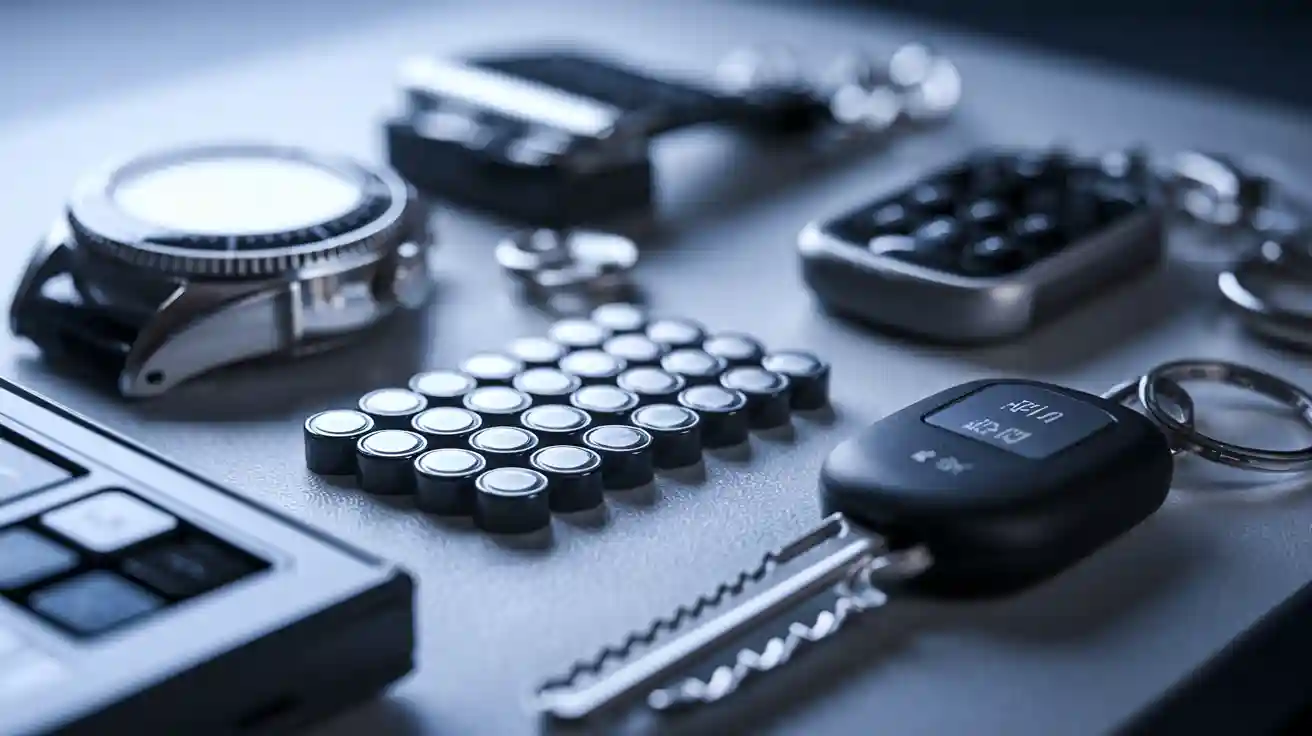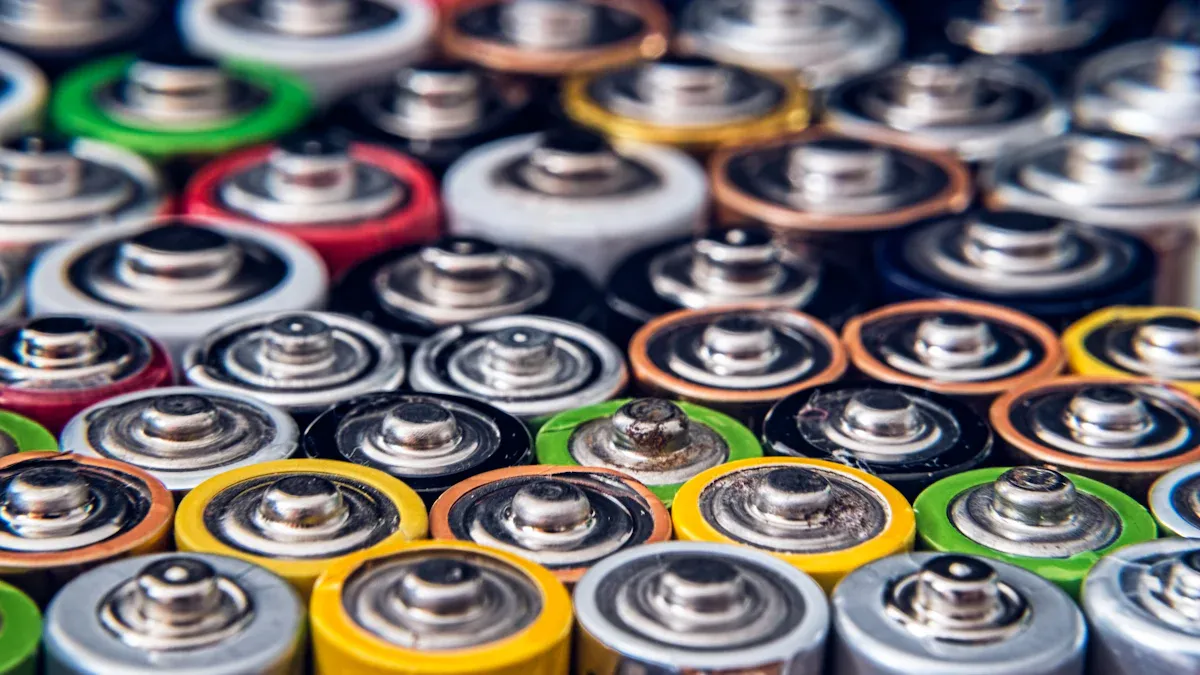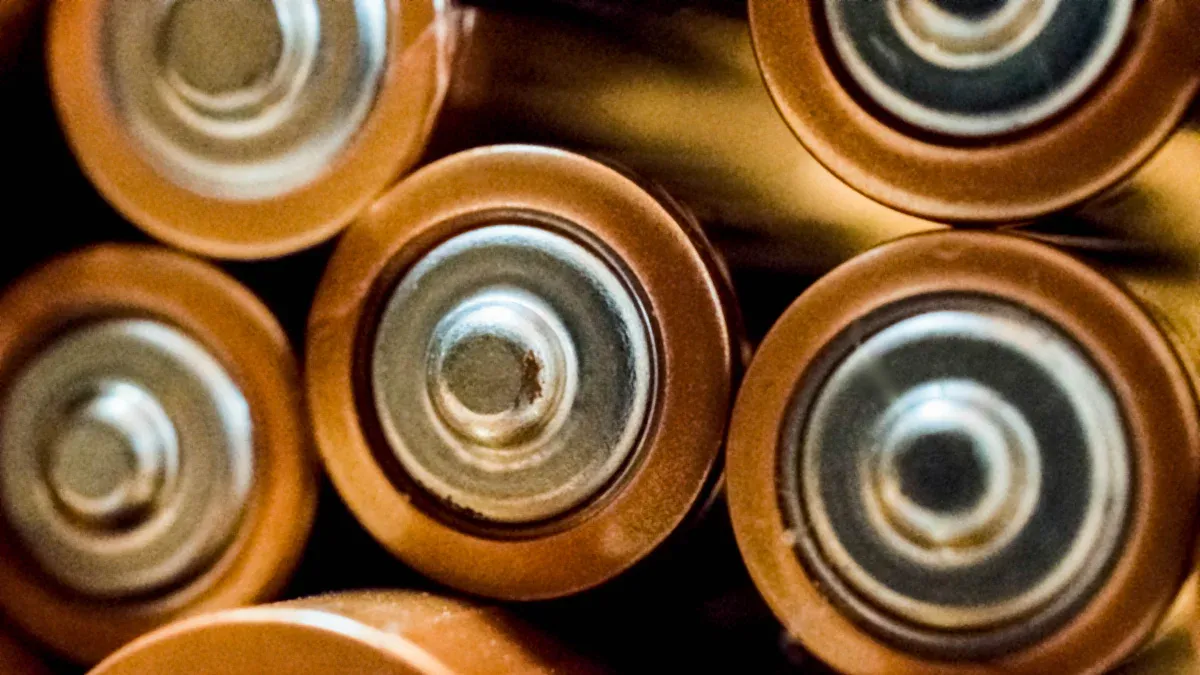
You find round lithium batteries in many devices you use every day. These batteries have a round shape and fit easily into compact spaces. Their main features include high energy storage and lightweight design. You rely on round lithium batteries for:
1. Smartphones
2. Medical devices
3. Toys
4. Cameras
5. Electric vehicles
Because of their versatility and reliability, round lithium batteries help power your daily routines.
What Are Round Lithium Batteries?

Key Features
You often see round lithium batteries in many devices because they offer a mix of reliability and efficiency. These batteries stand out due to their compact and lightweight design. You can fit them into small spaces, which makes them perfect for portable gadgets and wearables. Their high energy density means you get longer run times without adding extra weight. The round shape of each cell also helps with space efficiency, letting you use them in unique device designs.
Here are some main features that make round lithium batteries popular:
- Compact and lightweight, ideal for devices where every gram counts.
- High energy density, so your devices last longer between charges.
- Cylindrical shape fits easily into many device layouts.
- Consistent power output for steady device performance.
- Long cycle life, often lasting over 1,500 charge cycles.
- Fast charging and high discharge rates for better performance.
- Versatile use in wearables, medical devices, wireless earbuds, and cameras.
You can see how round lithium batteries compare to other shapes in the table below:
| Characteristic | Cylindrical (Round) Lithium Batteries | Other Battery Shapes (Rectangular, Pouch) |
|---|---|---|
| Manufacturing Process | Mature, highly automated, stable mass transfer | Less mature, semi-manual lamination process |
| Cost | Relatively low | Generally higher |
| Standard Sizes | Many standard sizes (14650, 17490, 18650, 21700, 26650) | Varies, less standardized |
| Shell Material | Steel shell housing (nickel-plated steel plate) | Different packaging materials |
| Structural Integrity & Safety | Steel shell provides strong structure and safety | Different structural properties |
| Winding vs Lamination Process | Mature winding process, lower defect probability | Lamination process less mature, higher defect risk |
| Tab Welding | Easier tab welding, better quality control | More prone to solder joint defects |
| Pack Grouping & Heat Dissipation | Simpler pack grouping, better heat dissipation | More complex pack design, heat dissipation challenges |
| Rate Characteristics | Slightly worse due to soldering multi-pole process limitations | Better rate characteristics with multi-pole solutions |
| Capacity Flexibility | Allows small capacity flexibility | Less flexible |
💡 Tip: When you choose a round lipo battery, you get a product that balances cost, safety, and performance for your everyday devices.
How They Work
You might wonder how a round lipo battery actually powers your device. Inside each cell, you find an anode and a cathode. The anode often uses lithium or graphite, while the cathode can use materials like manganese dioxide or lithium cobalt oxide. An electrolyte sits between these parts and lets ions move back and forth. A separator keeps the anode and cathode from touching, which prevents short circuits.
When you use your device, the battery creates energy through chemical reactions. The anode releases electrons, and the cathode accepts them. This flow of electrons generates the power your device needs. The lithium chemistry in these cells gives you a higher voltage—usually between 3V and 3.7V—and more energy in a smaller size. This is why your phone or smartwatch can run for hours on a single charge.
The round lipo battery uses advanced materials and design to improve safety, lifespan, and performance. New battery technology, like solid-state electrolytes and silicon anodes, aims to make these cells even safer and more powerful. These improvements help you get more out of your devices while keeping them lightweight and reliable.
Note: The choice of cathode material in a lithium battery affects how long your device runs, how fast it charges, and how safe it is. Always check your device’s requirements before picking a new battery.
Lithium Battery Types
When you look at the world of lithium battery types, you find three main designs that power your everyday devices. Each type has a unique structure, chemistry, and set of advantages. Understanding these differences helps you choose the right round lipo battery for your needs.
Steel-Shell Cylindrical
You see steel-shell cylindrical cells in many electronics, from flashlights to power tools. These batteries use a strong nickel-plated steel shell, which gives them excellent mechanical protection and acts as the negative terminal. Inside, the electrodes and separator get rolled up tightly in a spiral, forming the classic cylinder shape. This winding process keeps the cells safe from short circuits and helps them last longer.
Most steel-shell cylindrical lithium battery types use cathode materials like lithium iron phosphate (LiFePO4), lithium cobalt oxide (LCO), lithium manganese oxide (LMO), and ternary materials such as NMC (nickel manganese cobalt). The anode usually contains carbon-based materials like graphite. You often find these batteries in standard sizes, such as 18650, 16650, and 14500. The 18650 cell is especially popular because it balances size, capacity, and safety.
Here is a quick look at the typical components:
| Component | Common Materials |
|---|---|
| Cathode | Lithium iron phosphate, lithium cobalt oxide, lithium manganese oxide, NMC |
| Anode | Graphite, mesocarbon microspheres, petroleum coke |
| Shell Material | Nickel-plated steel plate |
You benefit from steel-shell cylindrical cells because they offer high safety, consistent quality, and mature production technology. These batteries cost less to make and work well in devices that need durability and reliability.
Tip: If you want a battery that lasts and stays safe under tough conditions, steel-shell cylindrical cells are a smart choice.
Steel-Shell Button (Coin)
Steel-shell button, or coin, batteries have a flat, round shape. You use these in small devices like watches, hearing aids, and car remotes. The compact design lets you fit them into tight spaces where other lithium battery types would not work.
These cells use a steel shell for protection and to serve as the negative terminal. Inside, the electrodes and separator stack in thin layers. The chemistry often includes lithium manganese oxide or lithium cobalt oxide for the cathode. The small size means you get less energy than with larger cylindrical cells, but you gain convenience and portability.
You can spot these batteries by their codes, such as CR2032 or CR2025. The first two numbers show the diameter in millimeters, and the last two show the thickness. For example, a CR2032 battery is 20 mm wide and 3.2 mm thick.
- Common uses: Watches, calculators, medical sensors, car keys
- Advantages: Small, lightweight, easy to replace
- Limitations: Lower capacity, not rechargeable in most cases
Note: Always check the label for safety marks like CE, UL, or RoHS. These marks show the battery meets important safety and environmental standards.
Soft-Pack Round LiPo Battery
You find soft-pack round lipo batteries in devices where space and weight matter most. These batteries use a flexible plastic composite film instead of a metal shell. This design lets you make the battery thinner, lighter, and even bendable. The round lithium polymer battery can fit into wearables, smartwatches, and wireless earbuds.
Soft-pack round lipo batteries use a polymer electrolyte, which allows for more customization in shape and size. The cathode can be lithium iron phosphate, lithium cobalt oxide, or NMC. The flexible packaging means you can design devices with unique shapes and curves.
Here is a table comparing soft-pack round lipo batteries and steel-shell cylindrical cells:
| Feature | Soft-Pack Round LiPo Battery | Steel-Shell Cylindrical Lithium Battery |
|---|---|---|
| Energy Density | Higher, stores more energy in less space | Lower, bulkier |
| Weight | Lighter | Heavier |
| Flexibility | Can bend and fit custom shapes | Rigid, fixed shape |
| Physical Protection | Less, needs careful handling | Strong, resists damage |
| Safety | Higher risk if overcharged or damaged | Safer under harsh conditions |
| Cost | Higher development cost, fewer models | Lower cost, many models |
| Applications | Wearables, portable electronics, light electric vehicles | Power tools, industrial, transportation |
You should choose a soft-pack round lipo battery when you need a lightweight, flexible power source. These batteries work best in devices that require a custom fit or need to stay as light as possible.
⚡ Remember: Soft-pack round lipo batteries give you more design freedom, but you must handle them with care to avoid damage.
Comparing the Three Main Types
You can see the main differences between these lithium battery types in the table below:
| Battery Type | Structure | Typical Chemistries | Best For |
|---|---|---|---|
| Steel-Shell Cylindrical | Wound electrodes, steel shell | LiFePO4, LCO, LMO, NMC | Power tools, e-bikes, cameras |
| Steel-Shell Button (Coin) | Stacked layers, steel shell | LMO, LCO | Watches, remotes, medical |
| Soft-Pack Round LiPo | Flexible film, polymer | LiFePO4, LCO, NMC | Wearables, earbuds, smart tech |
You now know the main lithium cell types and how each one fits different needs. When you pick a round lipo battery, think about your device’s size, weight, and safety needs. This knowledge helps you make the best choice for your gadgets.
Applications of Round Lithium Batteries

Round lithium batteries power many devices you use every day. Their unique shape and features make them perfect for a wide range of applications. You see these batteries in everything from smartwatches to medical equipment. The table below shows some of the most common applications and their market share:
| Application Category | Common Devices / Examples | Market Share / Notes |
|---|---|---|
| Electric Vehicles (EVs) | EV batteries | Largest market share; main driver of demand; strong global growth |
| Consumer Electronics | Smartphones, laptops, tablets, wearables | Major segment; high energy density and long lifespan |
| Industrial Equipment | Tools, mining equipment, low-speed EVs | Significant use; growing adoption |
| Medical Devices | Portable diagnostic, wearable, implantable | Growing need for reliable power supply |
| Other Applications | Telecom, marine, aerospace | Smaller but important segments |
Wearables and Watches
You rely on round lithium batteries for wearables and watches because they offer long life and stable performance. In smartwatches, lithium-polymer batteries give you more charge cycles and better heat resistance. This means your device lasts longer and stays safe. For analog watches, coin cell batteries can last up to 10 years, keeping your watch running with little maintenance. Their small size and light weight make them ideal for slim designs. You benefit from accurate timekeeping and reliable operation, even in extreme temperatures.
- Longer battery life (up to 10 years in watches)
- Stable voltage for accurate time
- Lightweight and compact for comfort
- Reliable in hot and cold conditions
Electronics and Remotes
Many electronics and remote controls use round lithium batteries because they fit small spaces and deliver steady power. You find these batteries in remote controls, electronic scales, and hearing aids. Steel-shell button batteries are popular for their sealed design, which prevents leaks. When you choose the right battery size and voltage, your devices work better and last longer. Always match the battery to your device’s needs for the best results.
| Battery Type | Advantages | Typical Applications |
|---|---|---|
| Steel-shell button-type | Small, sealed, ~3V, leak-resistant | Remotes, watches, toys, hearing aids |
| Soft-pack round lithium | High energy, flexible, space-saving | Wearables, compact electronics |
Tip: Store batteries in a cool, dry place and check for leaks to keep your electronics safe.
Toys and Gadgets
You see round lithium batteries in toys and gadgets because they provide safe and reliable power. Safety standards like UL 4200A and ASTM F963 require secure battery compartments and strong labeling to protect children. Manufacturers test these batteries for durability, impact, and resistance to tampering. When you buy toys with round lithium batteries, you get products that meet strict safety rules. This reduces risks like fire, explosion, or accidental swallowing.
- Secure battery compartments
- Clear warnings and instructions
- Tested for drops, impacts, and crush resistance
Medical Devices
Medical devices need batteries that are safe, reliable, and long-lasting. You find round lithium batteries in portable monitors, hearing aids, and implantable devices. These batteries must meet strict standards like UL 1642 and UL 2054 for safety and performance. The FDA and other agencies require tests for overcharging, short circuits, and safe transport. When you use medical devices powered by round lithium batteries, you trust that they meet high standards for your health and safety.
Note: Practical applications of lithium batteries in medical devices support life-saving technology and require careful regulation.
Round lithium batteries support high-performance applications across many fields. You benefit from their use in practical applications of lithium batteries, making your devices safer, longer-lasting, and more reliable.
Advantages of Round Lithium Batteries
High Energy Density
You benefit from the high energy density of round lithium batteries. This means you get more energy storage in a smaller and lighter package. Devices like smartphones, wearables, and medical tools rely on this feature for longer use between charges. When you compare round lithium batteries to older types, you see a clear difference in energy storage. The table below shows how energy density varies among common battery chemistries:
| Battery Chemistry | Energy Density (Wh/kg) | Key Notes |
|---|---|---|
| Lead Acid | 30-50 | Traditional, heavy, low energy density |
| Nickel-Cadmium (NiCd) | 45-80 | Moderate energy density, older technology |
| Nickel-Metal Hydride (NiMH) | 60-120 | Improved over NiCd, but heavier and higher self-discharge |
| Lithium Titanate (LTO) | 50-80 | Low energy density among lithium-ion, but fast charging and long cycle life |
| Lithium Iron Phosphate (LFP) | 90-160 | Medium-high energy density, very stable and safe |
| Lithium Cobalt Oxide (LCO) | 150-220 | High energy density, commonly used in consumer electronics, but less safe and more costly |
| Lithium Nickel Manganese Cobalt Oxide (NMC) | 150-220 | High energy density, balanced performance, widely used in electric vehicles |
| Lithium Nickel Cobalt Aluminum Oxide (NCA) | 250-300 | Very high energy density, used in automotive applications |

You see that lithium-ion chemistries, used in round batteries, offer much higher energy storage than older options. This advantage supports device miniaturization and better battery performance.
Long Shelf Life
Round lithium batteries give you a long shelf life. When you store them in a cool, dry place at about 40% charge, they can last 10 to 15 years with little loss of capacity. You avoid problems by keeping them away from heat and not storing them fully charged or empty. This long shelf life means you can keep spare batteries ready for use without worrying about quick degradation. Proper storage helps you get the most out of your investment and ensures your devices work when you need them.
Tip: Store your batteries at room temperature and check them every few months to keep them in good condition.
Mechanical Stability
You can trust round lithium batteries to handle bumps and drops. Their design includes a steel casing, a jellyroll structure inside, and a strong end-cap. These features protect the battery from damage and help it resist deformation. Advanced materials, like nanoporous electrodes and composite shells, add extra strength. The layered jellyroll inside spreads out stress, so the battery stays safe even under pressure. This mechanical stability is one of the key advantages, making these batteries reliable for portable and wearable devices.
- Nanoporous electrode networks reduce fracture risk.
- Composite shells reinforce the battery and manage swelling.
- 3D nanoarchitectures distribute stress and prevent failure.
- Steel casing and end-cap provide strong, lightweight support.
Compact Size
The compact design of round lithium batteries lets you power small and slim devices. You see these batteries in smartwatches, earbuds, and health trackers. Their small size allows manufacturers to fit them into tight spaces and even create custom shapes for unique gadgets. The compactness supports device miniaturization, giving you lighter and more comfortable products. You get high energy storage in a tiny package, which is perfect for modern electronics.
Note: The compact size of these batteries enables creative designs and helps you enjoy more portable technology.
Choosing the Right Lithium Battery
Device Compatibility
You need to match the right round lithium battery to your device for the best performance. Start by checking your device’s manual or official specifications. Look for the recommended battery type, voltage, and capacity. Devices often need specific cells, so always confirm the size, such as CR2032 or CR2025. Make sure the battery voltage matches your device’s needs. Using the wrong voltage can damage your device or cause it to malfunction.
Here are steps to help you choose the right battery:
- Check the device’s manual for the correct battery type, voltage, and capacity.
- Calculate how much power your device uses to find the right capacity.
- Match the battery voltage to your device’s requirements.
- Make sure the battery fits the size and weight limits of your device.
- Compare different battery types, such as lithium-ion, prismatic cells, and pouch cells, to see which works best.
- Pick batteries with a protection board to prevent overcharging and short circuits.
- Inspect the battery for good workmanship and proper labeling.
- Consider the cycle life of the cells to ensure long-lasting use.
Tip: Not all devices made for alkaline batteries work with lithium batteries. Always check before you buy.
Safety Tips
You must handle round lithium batteries with care to avoid accidents. Store spare cells in their original packaging or in separate plastic pouches. Cover the terminals with tape to prevent short circuits. Never carry loose batteries in your pocket or bag, especially during travel. If you need to dispose of old cells, do not throw them in the trash. Instead, cover the terminals and take them to a recycling center or a store that accepts batteries.
- Keep spent cells in a cool, dry place away from flammable items.
- Never mix lithium batteries with other battery types.
- Avoid crushing, puncturing, or dismantling cells.
- Use a rechargeable battery when possible to reduce waste and save money.
- If a battery leaks or swells, stop using it and recycle it safely.
Note: The future of lithium batteries depends on safe handling and proper recycling. Always follow local rules for disposal.
Customization Options
You can customize round lithium batteries to fit your device’s needs. Manufacturers offer different voltages, from 24V up to 72V, and capacities like 20AH, 50AH, or even custom values. You can also choose the size and shape of the cells to match your product. Some devices need prismatic cells for a slim fit, while others use pouch cells for flexibility. You can select the battery shell, such as iron or PVC, for extra protection or waterproofing.
Manufacturers let you pick the lithium chemistry, like LiFePO4 or NMC, to get the right balance of energy and safety. You can add a Battery Management System (BMS) for real-time monitoring and automatic protection. This helps you control the battery and keep your device safe. The future of lithium batteries will bring even more options for custom shapes and smart features.
| Customization Option | Examples/Range |
|---|---|
| Voltage | 24V, 36V, 48V, 72V, custom |
| Capacity | 20AH, 50AH, 100AH, custom |
| Cell Type | prismatic cells, pouch cells |
| Shell Material | Iron shell, PVC film |
| BMS Features | Monitoring, protection, Bluetooth |
⚡ Customizing your battery ensures your device gets the best power, safety, and fit.
You now understand how round lithium batteries power your devices with reliability and safety. These batteries last longer, perform better in extreme temperatures, and include built-in protection. Check your device’s needs, choose trusted brands, and look for safety features like battery management systems.
| Aspect | Lithium Batteries | Alkaline Batteries |
|---|---|---|
| Cost | Higher upfront, lasts longer | Lower upfront, more replacements |
| Longevity | Hundreds to thousands of cycles | Shorter lifespan |
| Safety | Low leakage risk, built-in protection | Higher leakage risk |
Remember: Avoid overcharging, keep batteries cool, and inspect for damage. Choose the right battery to keep your devices running safely and efficiently.
FAQ
What is the difference between a lithium-ion and a lithium-polymer battery?
You find lithium-ion batteries in hard metal cases. Lithium-polymer batteries use soft, flexible pouches. Both store lots of energy, but lithium-polymer batteries weigh less and fit into slimmer devices.
Can you recharge all round lithium batteries?
You can recharge most cylindrical lithium-ion batteries. Many button (coin) lithium batteries are not rechargeable. Always check the label or your device’s manual before trying to recharge any battery.
How should you store round lithium batteries safely?
You should keep batteries in a cool, dry place. Store them in their original packaging or a plastic case. Avoid heat, moisture, and direct sunlight. Do not let batteries touch metal objects.
What should you do if a lithium battery leaks or swells?
Stop using the battery right away. Place it in a non-flammable container. Take it to a battery recycling center. Do not throw it in the trash or try to fix it yourself.

